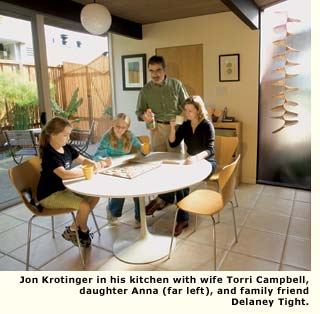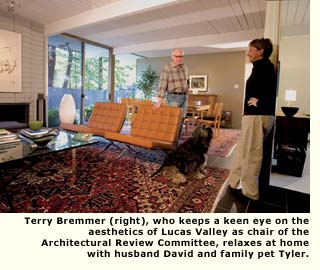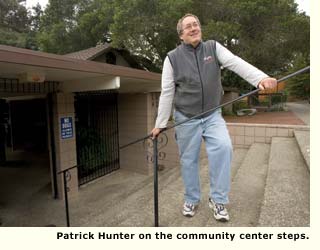The Eichlers of Lucas Valley - San Rafael - Page 2
The Eichler homes, designed by Jones & Emmons and Claude Oakland, and built from 1963 through 1967, are typically low-slung and unpretentious, but atypically well-preserved both individually and as a group. Styles are varied, but harmonious. The homes that most stand out, perhaps because their peaks echo the hills beyond, are the dramatic gable models, whose bold designs feature two peaked roofs bracketing an atrium. About 130 homes in the neighborhood are ranch-style homes by another developer.
Houses are arrayed on gently curving streets that make for easy biking by both kids and adults, and are shaded by a forest primarily of live oaks, bays, and buckeyes.
The neighborhood is even more remarkable at night, when it becomes one of the few urban locations in the Bay Area where you can actually see stars. Eichler banned not just utility poles but streetlights, wanting nothing to soar above his rooftops except trees.
Afternoons, however, are the best time to see Lucas Valley in action. You'll see golden retrievers ambling out of driveways, and kids walking or bicycling home from school, the famous kindergarten-through-fifth grade Dixie School. This is one neighborhood where children play freely out of doors, though parents warn them to beware of traffic during "getting-off-work time."

The school, more even than the residential architecture, draws people to the neighborhood. "Dixie School is an extraordinary school and people want to come there," says Hunter.
As in many mid-century modern communities, people here collect George Nelson clocks and restore their homes. But it's family more than '50s fetishism that cements friendships.
Jon Krotinger and Torri Campbell moved to Lucas Valley because they were looking for a nice neighborhood for their daughter Anna. Only then did they fall in love with the architecture. "I'd never seen anything like it," Krotinger says. "We used to joke that we were looking for a house that is both cozy and spacious. We used to joke, that can't be. But that's exactly what this is."
Folks get to know each other through Dixie School and the youth swim team, the Lucas Valley Lightning, the tennis club, and other activities, many centered on the heavily-used community center, also built by Eichler. Hunter's daughter swims for the Lightning, as did his wife a generation ago. Like all parents, the Hunters are deeply involved as volunteers. Their rewards include community barbecues, friendships.

"There is extraordinary community unity," Munson says. "People support the schools, the little league, the swim team, blood drives. The size of Upper Lucas Valley is the perfect village size."
Besides the community center and its pool, the homeowners association's recreational facilities include tennis courts, hillside trails, other landscaped areas, and the stables. The result, Hunter says, is a fair amount of community feeling—though nothing like he knew in his hometown of New Orleans. "I'm from the South," he says. "We had front porches that were open to the streets and you saw your neighbors walking by. Here people have to find other ways to get involved."
For Marinoff, in 1963, getting involved was easy. As he tells the story, all the area had for fire protection was "one wildland grass engine with one guy." So, he says of the neighborhood, "We did something."
Marinoff and about 20 neighbors formed a volunteer fire department, raising funds door by door for coats and boots. Marinoff fought fires for 15 years—including years when "we had an arsonist or two loose so we had a lot of fires in the hills." Neighbors also created County Service Area 13, a special district created by the county to provide fire protection, and established a tax to pay for added fire protection. The agency contracts with the nearby Marinwood Fire Department for fire protection and San Rafael for paramedic service.

Neighbors also created their own cable TV system, thanks in part to Eichler's desire to avoid what Marinoff calls "the god-awful" rooftop antennas that marred most neighborhoods at the time. Eichler laid underground TV lines and set up two community antennas. The homeowners association later replaced them with a satellite dish in the hills. The association runs the cable system, with rates that are far lower than the competition. They also offer bargain rates on fast Internet access.




